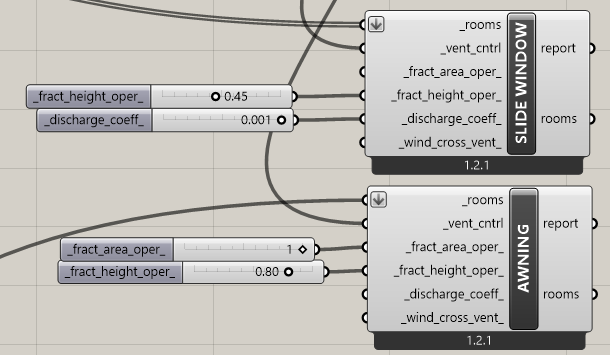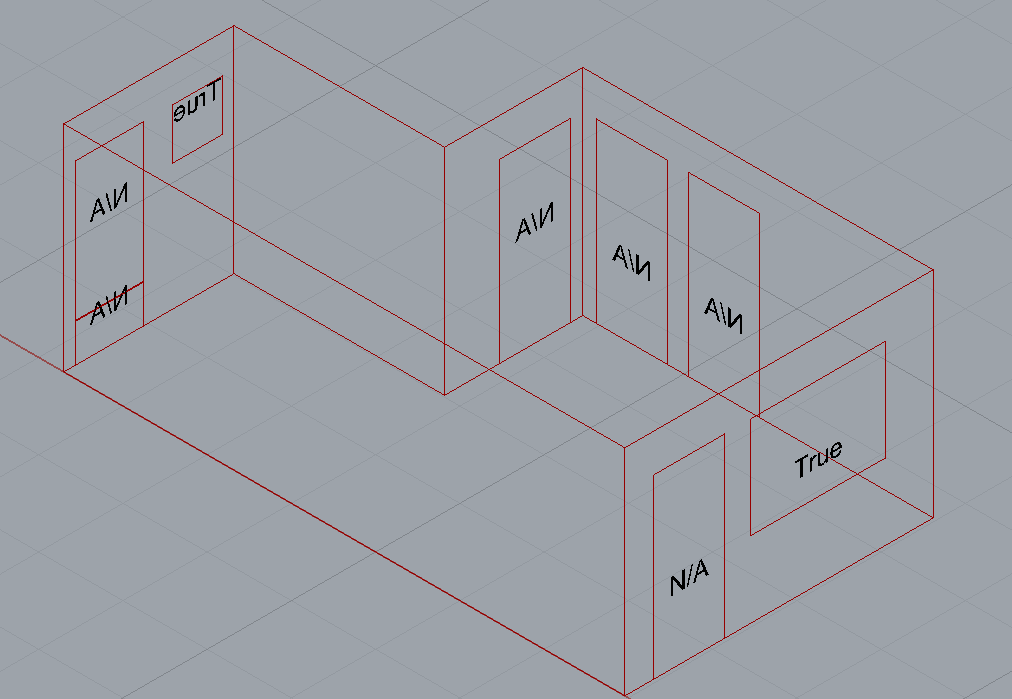Hello guys
I need your help to learn to use the HB.
This time de most important thing is to use de Air Flow network.
To contextualize:
I’m Brazilian and I’ve started to learn EnergyPlus recently in graduation classes.
So as LBTools’ user I want to translate the IDF with I’ve used in classes to grasshopper environment. So I’m facing some issues to adapt to Brazilian’ standards.
I’m trying to build the ventilation system using the Air Flow Network but I’m not sure how to migrate it’s information to HoneyBee (HB). So I have some questions:
-
Can I create or adapt this data to the HB using the “HB WINDOW OPENING”?
I’m assuming the “Height Factor for Opening Factor2” will correspond to “_fract_height_oper”.
If correct, can I apply the “Width Factor for Opening Factor2” some how?

-
Can I insert 2 different types of windows in the same room?
In the image bellow shows shows the operable apertures of a room. The doors are marked as N/A.
It has the 2 operable windows, the biggest one in right below (noted “True”) is a slider type and the left is an awning type.
3 Can I control the door in the simulation?
In Brazilian standards, I need to do 2 simulations: one with the ventilation with all doors and windows open (if the interior’s air temperature is larger than the exterior air temperature or 19ºC) except the bathroom’s door, with is closed, in the whole year. And no ventilation simulation, with all doors and windows closed.
Can I apply an air wall material for the open ones? I don’t know how the program will deal with it.
In this case I found these 3 materials to apply: “F04 Wall air space resistance”, “Generic Wall Air Gap”, “Typical Air Wall”. Are they applicable to this situation?
Thanks for your attention.
Thanks for this amazing software.
Ps: I’m not native English speaker, so let me know if my text is not clear enough to you. So I can try to be more clear.
@MR_Yuki
The HB AFN is implemented with the AFN SimpleOpening[1] EP object, and it looks like you are using the DetailedOpening[2] equivalent, so you won’t be able to perfectly translate your class IDF to HB using current HB AFN component.
Re: 1 & 2 the best I think you can do to capture some of the missing parameters (i.e window type) by modifying the parameters required by the SimpleOpening object to capture your more detailed requirements. This would work similar to how you can modify discharge coefficients to capture the difference between cross versus single-openings, and will require some research. Of course this is a fairly crude solution, it’s just assuming there’s some average loss/gain in the detailed model components that can entered as a weighting factor into the simpler model’s parameters upfront.
Re: 3, I’m not sure I understand this question. What is wrong with the default behaviour of the AFN when windows/doors are open that requires modeling openings with an air wall instead? My interpretation of your Brazilian standard is that it requires you to set the AFN with the air temperature rules you mentioned for all relevant openings?
[1] Group – Airflow Network: Input Output Reference — EnergyPlus 9.3
[2] Group – Airflow Network: Input Output Reference — EnergyPlus 9.3
Hey @SaeranVasanthakumar Thanks for your guidance.
I will try the 1 & 2 as soon as possible.
For 3 I haven’t found a way to control de doors using the HB just like the windows. I will try your recommendation.
For an long explanation of the standard.
In the EnergyPlus we set the temperature to open the windows and doors in this condition: if operative temperature is > 19ºC or the outside temperature is higher than inside to follow the normative.
To clarify: this standard demands to simulate the same building twice:
-
The precise project in the real condition. Applying the natural ventilation with that rule in all doors and windows open, besides the bathroom.
In other words, an well performing situation.
-
The reference model. It’s an minimum reference construction for the same project.
By this way I can assure it’s an better project than the “minimum”. I need to change the materials and constructions, remove shadings, considerer all openings closed, etcetera.
So it’s like an worst case scenario practically.
With this data I can compare the operative temperature in the rooms for long occupancy rooms(I don’t know a better word, so it’s when are people using the room for long time). So focus in bedroom and living rooms.
With this data I can compare both results and check how better the real project is comparing how much hours in comfort the room and home(mean of all relevant rooms) will have, compare de max and min temperature values.
It’s the basics for the normative.
Again, thank.
@MR_Yuki,
Yes, you’re right. Actually I think there’s 2 obstacles in the way of achieving the standard: the door, and the operative temperature.
The door is an obstacle because the ventilation control logic is only applied to windows openings. I think you can resolve this by simply building a window assigned with door-like thermal/visual properties rather than using an air wall, since the door being closed wouldn’t be captured by an air wall.
The operative temperature is an obstacle because the ventilation control logic is based on dry bulb temperature. Since this is dynamically checked by the EnergyPlus’ EMS system, it’s not something that is easy to change upfront. I can’t think of a solution to this, so you may have to just to assume that the radiant temperature is the same as the dry bulb for your simulations. I think this is a reasonable simplification as long as you don’t have any extreme surface temperature/view factor configurations in your model.
Everything else I think you can do easily in HB.
Oh cool.
Thanks for your assist.
I will look again about the air and operative temperature to see witch is functional for me.
The standard’s authors are EP users too.
Sound good!
I will look again about the air and operative temperature to see witch is functional for me.
The standard’s authors are EP users too.
Just to clarify, the problem with using operative temperature is not EP, it’s Honeybee. The control logic for the AirflowNetwork in Honeybee only checks dry bulb at the moment.
1 Like


